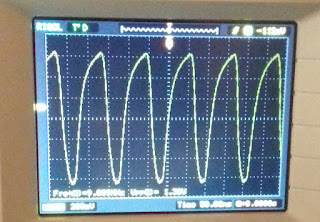Friday afternoon....going to prepare dinner, egg beater is needed.... it works first time and then stops...no bang.... after a days work troubleshooting I don't need more of it :)
There are only 3 possible faults for a mains powered device:
1 - No power
2 - Open circuit
3 - Short circuit
There was power and there was no short circuit, leaving the open circuit possibility, in fact it was immediately confirmed since no resistance was measured from the power terminals... I only hoped it had not been a short on the engine windings causing the open circuit.
I confess that opening was easier than closing in the end, mainly due to mechanical interlock of the eject mechanism.
Here's the fault....
..on the speed/on/off switch, since it rotates (the transparent plastic part, along with the center washer) the wire broke at the terminal (mechanical stress).
In the picture was already in place for soldering, should last another year or two.
And pictures in the process of finding it:
... Sabichi brand...at least the electric motor looks reasonably built.
Just looked their website (https://www.sabichi.co.uk/the-company), that's not bad since most brands are just a sticker:
".....with one mission – to bring fantastic quality homewares to our consumers in the UK at a great price. We haven’t looked back since...."
.....Marketing.... it just means: bring Chinesiun or Eurocrap lower grade devices, re-brand and sell for the highest possible price...
Anyhow, even in our hobby we are seeing the same...
Have a great 2018!
There are only 3 possible faults for a mains powered device:
1 - No power
2 - Open circuit
3 - Short circuit
There was power and there was no short circuit, leaving the open circuit possibility, in fact it was immediately confirmed since no resistance was measured from the power terminals... I only hoped it had not been a short on the engine windings causing the open circuit.
I confess that opening was easier than closing in the end, mainly due to mechanical interlock of the eject mechanism.
Here's the fault....
..on the speed/on/off switch, since it rotates (the transparent plastic part, along with the center washer) the wire broke at the terminal (mechanical stress).
In the picture was already in place for soldering, should last another year or two.
And pictures in the process of finding it:
... Sabichi brand...at least the electric motor looks reasonably built.
Just looked their website (https://www.sabichi.co.uk/the-company), that's not bad since most brands are just a sticker:
".....with one mission – to bring fantastic quality homewares to our consumers in the UK at a great price. We haven’t looked back since...."
.....Marketing.... it just means: bring Chinesiun or Eurocrap lower grade devices, re-brand and sell for the highest possible price...
Anyhow, even in our hobby we are seeing the same...
Have a great 2018!























































